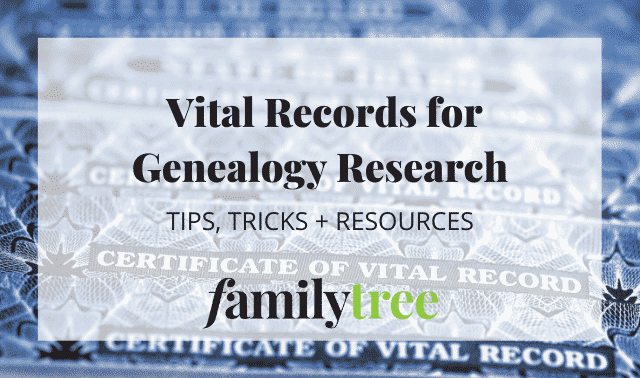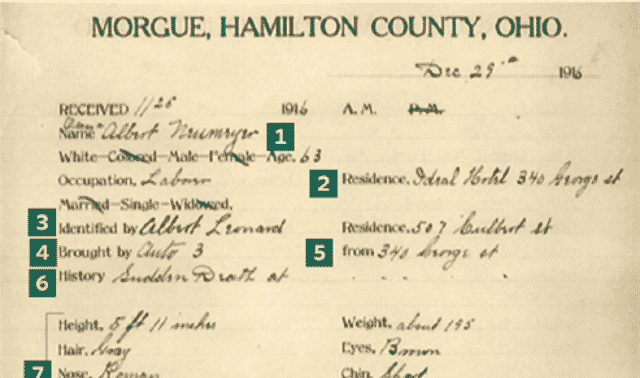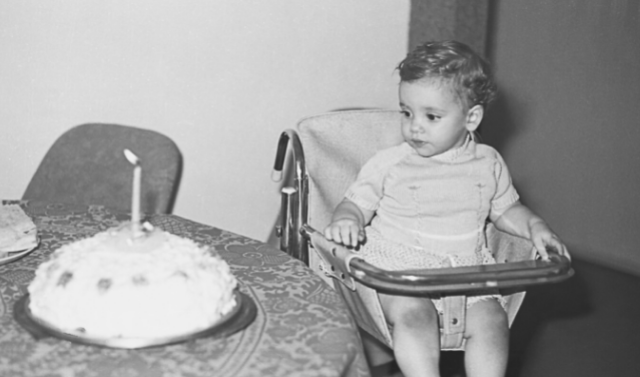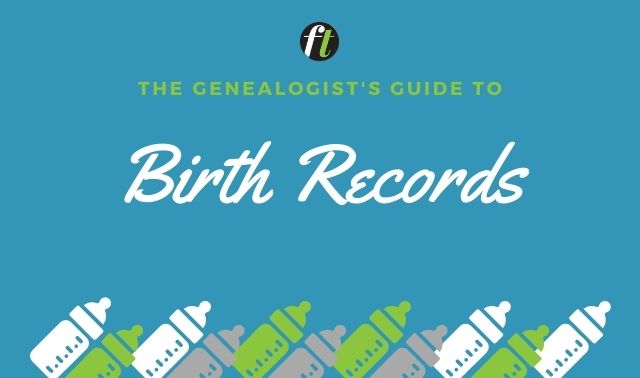
Jump to:
Clues in death records
Death record coverage
Accessing death records
What can you find in a death record? Two sample records
Death record substitutes
Related Reads
https://www.youtube.com/watch?v=ej8NiJ40UUM
When researching your ancestor’s story, many genealogy experts recommend beginning with the final chapter—the record of an ancestor’s death. After all, a death certificate or other death record represents the most recent evidence of your ancestor’s life.
This guide will show you what’s in a death record, how to find one, and what other records include the death information you seek.
We’ll also provide a worksheet you can download to map out your death records search.
Clues in Death Records
The death certificate is considered a primary source for the details of an ancestor’s passing, such as the date, place and time of death.
It also can be a rich secondary source for an ancestor’s life, providing clues to everything from birth and parents to spouse and last residence. Such information on death records is considered less reliable because it comes from the informant—typically a spouse, child or other family member.
Not only would the informant have been grieving, but he or she would have only second-hand knowledge of facts such as the deceased’s date and place of birth or his parents’ names. Research other sources to confirm the data a death record provides on a person’s life.
Nonetheless, particularly from more recent years, a death certificate can deliver a wealth of information. The names you find in a death record can of course lead you to other relatives, and perhaps even push back your genealogical search by a generation (pending confirmation from primary sources). The name of the informant could also be exactly the clue you need to solve a maiden-name mystery.
Place names, however, can provide equally important clues: An ancestor’s burial location can lead you to the cemetery, where previously unknown relatives may be in nearby graves.
A residential address can aid your search in census records, city directories or land records. Besides filling in blanks in your family tree, dates can point to other records—newspaper obituaries, passenger records, other vital records.
Even the cause of death can be helpful, whether in building a medical family history or (in cases of accidental or criminal causes) prompting a search for newspaper articles about the fatality.
Death Record Coverage
Today we think of every death as being carefully scrutinized and recorded. Even if a deceased person doesn’t undergo the sort of medical examination common on TV shows such as “CSI:” or “Bones,” at least a funeral home is involved and a sheaf of paperwork generated. People in 21st-century America who leave this world are just as well-documented as when they arrive in it or get married.
Unfortunately for genealogists, however, such meticulous recording hasn’t always been the case. Depending on where and when your ancestor died, death records may be skimpy or even nonexistent. It’s surprising in our data-dependent era to learn that some states didn’t require recording of deaths until the first decade or so of the 20th century.
The earliest state to start death registration is Massachusetts, in 1841, followed by New Jersey in 1848. Recording in Southern and the newer Western states was generally later, with official death records beginning in Louisiana, Tennessee and Arkansas only in 1914, and South Carolina in 1915. Illinois was the last Midwestern state, in 1916. West Virginia followed in 1917; New Mexico and Georgia were last to start recording deaths, in 1919.
Even after statewide death registration began in a state, compliance from border to border may have taken another few years, and you may find gaps in the records. But individual towns or counties may have started records much earlier than the states. In Virginia, for example, which waited on statewide records until 1912, some counties kept death records (including for those who were enslaved) as early as 1853. Louisiana, although among the last to adopt statewide registration, has some county death records as far back as 1803.
Many New England towns started keeping death records in their earliest days, dating to the 17th century. In other places, major cities may have begun death registration well before the rest of the state: St. Louis recorded some deaths, for instance, from 1850 to 1910, and Charleston began in 1821, nearly a century before South Carolina mandated it. The information in early death records, particularly those at the town or county level before statewide registration, may vary widely from place to place.
Although privacy restrictions more commonly affect the availability of birth records, you may run into some such roadblocks with death certificates, too. Death certificates may be blocked for a period of years after the death, usually 20 to 50. Some states completely restrict access, regardless of how long ago the person died, to “qualified applicants” (usually those who are direct descendants or who need the information to prove provenance).
Accessing Death Records
The original repository for most death records was an office, such as the health department or vital records office, in the county where the death occurred. Depending on the date of the record, you might get a copy there, or hit up another repository.
State and county offices
Generally, you’ll request copies of death records created after statewide death registration began from state vital records offices or health departments. You can find these offices’ websites with a web search (Ohio death certificates or Ohio vital records, for example). Or consult the Centers for Disease Control and Prevention’s list of links to state vital records offices.
County or city offices covering the place where the death occurred also may provide access to death records, and they may have fewer access restrictions and lower fees. They’ll also likely have any records kept before statewide death records began. Check the department of health website for the locality where the death took place for details.
Whether you request from the county or the state, follow the site’s instructions for submitting your order. You may have to print a form to drop in the mail with a check, or submit an online form with a credit card number. Fees generally range from $6 to $15. Usually, you’ll have to provide at least the deceased’s name at death and the date and place of death. If you know the death certificate number, supply that as well.
You can order the same records available at state vital records offices through third-party businesses such as VitalChek. (In fact, in some states, this is your only option).
Such businesses often provide faster service, but usually for a higher fee. Early death certificates may have been transferred to a state or county archive, library or historical society. The health department or vital records office website should inform you if this is the case, or you can consult local genealogy guides.
Online
A handful of states and localities provide online access to digitized death records for at least some span of years. Arizona offers a searchable index covering 1844 to 50 years ago, linked to PDFs of the originals. Nearly a million Michigan death certificates from 1897 to 1920 are digitized at Michiganology.
You might find your ancestor in a death index, compiled by someone who looked through death records and extracted names, death dates and other pertinent details. Use this data to request the actual record. The index may have a link to order the record from the holding agency. If not, examine the site for information on the source of the records and directions for ordering a copy or finding it on microfilm. The Massachusetts state archives, for example, indexes deaths from 1841 to 1910 and tells you how to request records.
Death records or indexes are increasingly available online at FamilySearch. Click Search, then Records, where you can narrow by location via a clickable map of the United States. Click a state, then look for a death records title on the list in the resulting page. Some of the collections are still being added to, and not all are indexed.
The Social Security Death Index (SSDI), also on FamilySearch, is a quick way to find the death date and place of ancestors recent enough to have Social Security numbers. The collection begins in 1962, the year the database was computerized.
Most subscription genealogy sites have death records and indexes, most notably MyHeritage and Ancestry.com. Search these sites’ list of collections by place, then scroll to see whether death records are available. Especially for New England ancestors, the American Ancestors subscription site from the New England Historic Genealogical Society may have local death records unavailable elsewhere online.
To find these record collections and indexes, run a Google search on the city, county or state, death records and genealogy. Also check websites of the state archives and the state and local genealogical society. Search online for books containing death indexes, too.
Microfilm
The Family History Library has microfilmed death records and indexes for locations across the country, and (as of writing) is in the process of digitizing all its microfilm. Search the FHL online catalog for the place your ancestor may have died, then scroll through the results for death records. State archives and local libraries also may have microfilmed death records you can borrow through interlibrary loan.
What Can You Find in a Death Record? Two Sample Records
Death Certificate
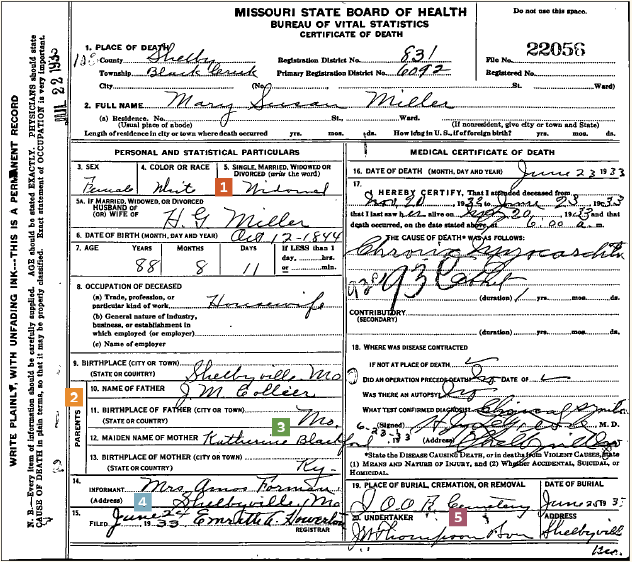
- Take note of the deceased’s marital status as well as spouse’s name; here’s evidence that H.G. Miller died before June 1933.
- Sometimes death records provide useful clues for further research, such as the name and birthplace of the deceased’s father.
- Sources for finding a mother’s maiden name can be scarce. But now you can follow up searching for Blackfords in Kentucky, and for a marriage record for Katherine and J.M. Collier.
- An informant’s name can provide clues: This informant’s last name is different from the deceased’s maiden and married names. How is she related—possibly a married daughter?
- The name of the undertaker can help you find funeral-home records that could contain more information.
Obituary

- Obituaries typically give the deceased’s age and place of birth (which can lead to birth records) and survivors’ names—though the wife and children aren’t named here.
- Details of Mr. Brownlee’s death on the Gettysburg battlefield are clues to discovering records of his military service. Keep in mind tales of heroism may have been embellished.
- Shorter death notices offer basic facts about the date, place and cause of death. These name the survivors, candidates for further research.
- Vital record-keeping gaps during the Civil War in many places mean newspapers may be the only source for death information.
- Newspapers are generally considered secondary sources of information, because a reporter’s accounts are based on someone else’s recollection. Try to confirm details in other sources.
Death Record Substitutes
If your search for official death records fails, or you need to supplement skimpy information in what you’ve found, other resources can help. Of course, there are cemetery and tombstone records, but don’t overlook funeral home, newspaper, church and even census records:
Funeral records
The information in these records may include names of family members, details of the funeral service and even the cost of burial. You may be able to identify the funeral home from the death certificate, newspaper obituary, cemetery records or family papers. A funeral home that nearby relatives used is a likely bet, or you can check city directories of the time for funeral homes near where the family lived. Then you can try to locate the funeral home today (or its successor), either through a web search or directory websites such as Funeral Homes or US Funerals.
A printed directory to US funeral homes, which your library or a cooperative local funeral director may have, is The American Blue Book of Funeral Directors (Kates-Boylston). Historical societies and libraries in your ancestor’s hometown also might help you track down funeral homes, especially those that’ve been absorbed by other homes. When contacting a funeral home, remember that it’s a private business. While funeral homes are often helpful to genealogists, they are under no obligation to be. You may be asked to demonstrate your connection to the deceased.
Newspapers
The local newspaper may have recorded your ancestor’s passing in the form of a death notice listing just the basic facts, or an obituary with details about his life and family. The proliferation of online digitized newspapers can help you find these. Try Ancestry.com and its sibling site Newspapers.com, both of which require a subscription; subscription site GenealogyBank, which also has a database of recent newspaper obituaries; subscription site Archives.com; and the free Chronicling America site from the Library of Congress.
Several states have online newspaper collections, including Colorado, Georgia, and others. Ask your library if it subscribes to ProQuest Obituaries, a service that offers millions of obituaries from newspapers dating back to 1851. Newspaper Obituaries on the Net is a collection of links to other websites. And the USGenWeb Obituary Project provides transcriptions of public-domain obituary indexes and transcriptions, organized by state and county.
In addition, check archives, historical societies and libraries in the area where your ancestor lived for indexes to obituaries and death notices, such as those of Alaska Libraries, Archives and Museums and the Wisconsin Historical Society. You can also use an online search engine such as Google or Bing to look for ancestors’ obituaries. Try searching for a name plus obituary; include a place if the deceased’s name is common.
Church records
Many churches recorded the deaths of their members in funeral registers. Your research strategy for these records varies by the religion. Your best bet is to contact the place of worship your ancestor attended. If it no longer exists, contact the parish that absorbed it or a regional office for the faith. You also might find church records microfilmed through the Family History Library: Run a place search of the FamilySearch online catalog and look for a church records heading.
Coroner records
Deaths occurring by accident or under suspicious circumstances may have been subject to a coroner’s investigation. The death certificate and newspaper articles may indicate such a death. Coroner records may be at the county morgue, historical society or state archives. Old coroner records are online, at least in index form, for a few areas, such as St. Louis and Summit County, Ohio.
Census mortality schedules
US census mortality schedules for 1850, 1860, 1870 and 1880 name those who died in the 12 months prior to the census date (June 1) for these censuses. Find mortality schedules on Ancestry.com. The 1850 schedule is searchable free on FamilySearch.
Military records
For ancestors who died in military service, search the Nationwide Grave Locator, which lists burials in Veterans Administration National Cemeteries, state veterans cemeteries, other military and Department of Interior cemeteries, and veterans buried in private cemeteries with government grave markers furnished after 1997. Also peruse military records and pensions on the subscription site Fold3.
One way or another, your ancestor’s final chapter is out there for you to read. And what you find out about his death may open a whole new window in learning about his life.
Versions of this article appeared in the the October/November 2013 and September/October 2021 issues of Family Tree Magazine.
Related Reads
Pin it!


